
When you plant lettuce, if it does not grow well, you don't blame the lettuce. You look into the reasons it is not doing well. It may need fertilizer or more water, or less sun. You never blame the lettuce. Yet if we have problems with our friends or family, we blame the other person. But if we know how to take care of them, they will grow well, like lettuce. Blaming has no positive effect at all, nor does trying to persuade using reasons and arguments. That is my experience. No blame, no reasoning, no argument, just understanding. If you understand, you can love, and the situation will change.
~ Venerable Thich Nhat Hahn

The teachings of Thich Nhat Hahn, a Vietnamese Zen Buddhist monk, provide fresh insight and perspective on daily living and relationships. Whenever anyone wants to change a habit, I recommend his Dharma Talk on Transforming Negative Habit Energies which I found to be very helpful.
I read his lettuce teaching for the first time a couple of years ago, and now whenever I see or eat lettuce, I think of its profound lesson. If this is the only lesson to be accepted, learned, and practiced, what a world of difference it would make, what peace it would bring. To understand, to love. Simple really. We'd hope others would understand and love us, and yet sometimes it's seems difficult to do the same for them. Remembering the lettuce helps, it reminds us that it can be that simple, that it doesn't have be difficult or complicated. It merely requires us to let go of our need to be "right". The lettuce lesson is easy to remember with this mnemonic device:
Lettuce not blame or judge one another;
Lettuce understand and love one another.
What better way to keep this teaching in mind, then to incorporate lettuces into your visual and edible landscape?
Growing up Roman Catholic, there are many rituals, one of which is to bless yourself when the Gospel is read by making the Sign of the Cross on your forehead, mouth and heart as a gesture to keep Jesus' teachings in your thoughts, in your words and in your heart. Sometimes I think food, a significant source of life, requires the same awareness and appreciation of connection of mind, mouth and heart. Think about where your food comes from and how it is grown. Eat what is wholesome and allow it to nourish you. Take its lessons to heart.
Lettuce is soon becoming one of my favorite things to grow. Once you understand and meet the basic needs of lettuces and leafy greens, they are quite easy to grow, and the fruits of your labor are apparent rather quickly as the seeds germinate within a couple of days of planting. You can start them indoors in seedling trays and then transplant them outside. You can grow them in cold frames, hoop houses or greenhouses during the winter months as they are very cold hardy, they even can handle some frost. They grow in a magnificent array of colors and textures which make it fun to incorporate into your garden plan or pots. Each lettuce has its own distinctive taste, some mild, some bitter, some peppery.

This year I am growing an assortment of lettuces and leafy greens, some I have never knowingly tried before. I am looking forward to eating fresh, homegrown meals all summer. My hope is by growing lots of lettuces, we'll eat more salads and reap the benefits of a healthier diet and a less hot house. Here's what's growing in my garden:
Rouge d'Hiver (heirloom)
Sucrine
Winter Density
Red Iceberg
Black Seeded Simpson (heirloom)
Organic Blend (containing Grand Rapids, Oak Leaf, Salad Bowl, Red Salad Bowl & Prize Leaf)
Sylvetta Arugula
Red Russian Kale
Komatsuna
Tatsoi Spoon Mustard
Swiss Chard
Here are some articles I found very useful when learning the ins and outs of growing lettuce:
Cut-and-Come-Again Lettuce Sampler: A Whole Palette of Colorful Varieties Delivers a Leafy Feast, by Peter Garnham, from Kitchen Gardener Magazine #19, pages 10-14.
All About Growing Lettuce, by Barbara Pleasant, Mother Earth News Magazine.
Lettuce, Organic Gardening Magazine.
No comments:
Post a Comment